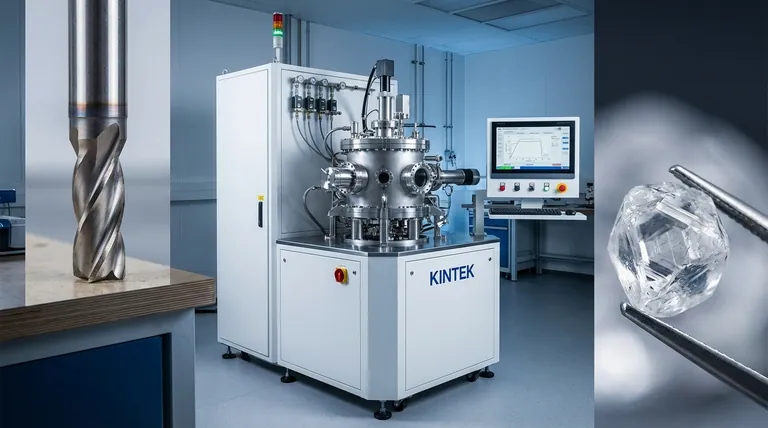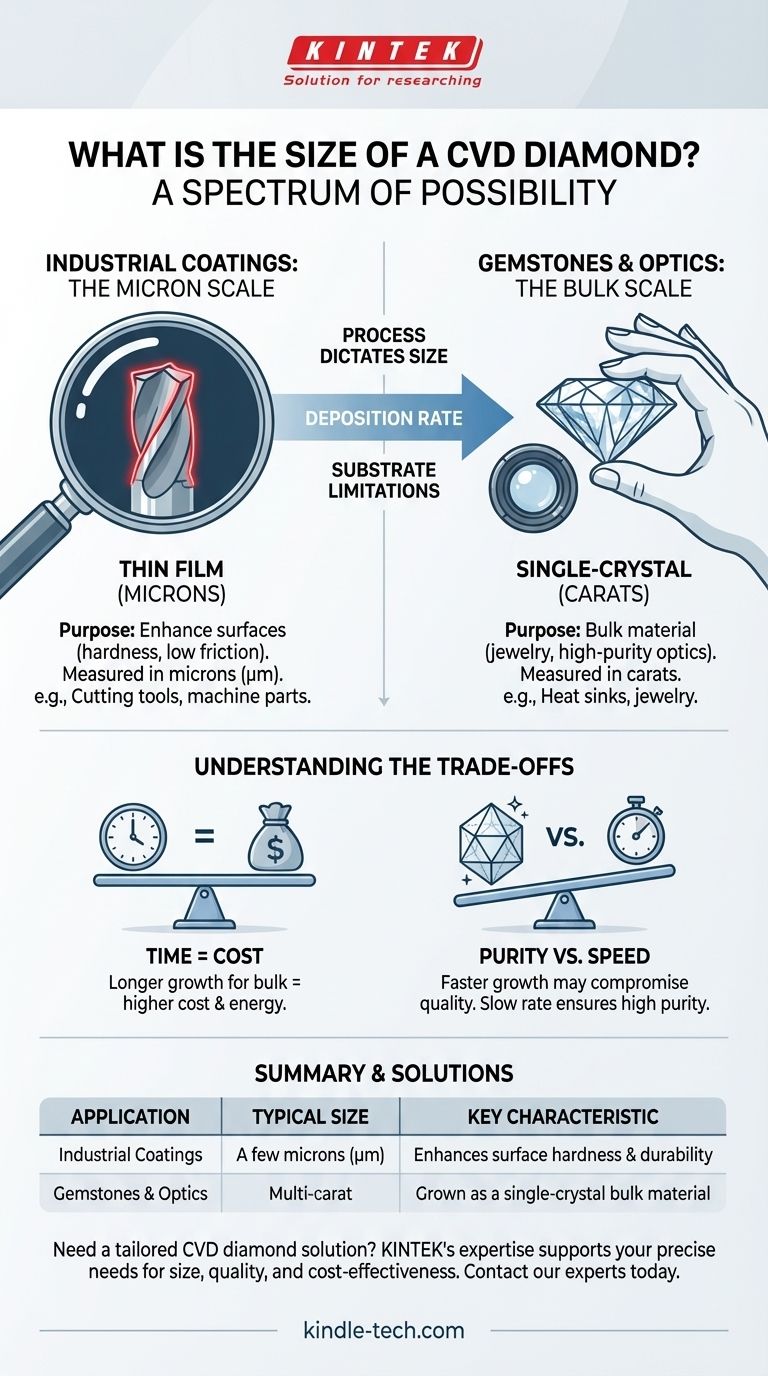The size of a CVD diamond is not a single measurement but rather a spectrum dictated entirely by its intended purpose. For industrial applications, a CVD diamond is an ultra-thin coating measured in microns. For jewelry or high-performance optics, it is a "fully grown" bulk diamond whose size can be equivalent to multi-carat natural gemstones.
The term "CVD diamond" describes two fundamentally different products. One is a microscopic, functional coating designed to enhance a surface, while the other is a macroscopic, single-crystal diamond grown for its bulk properties. The size is a direct result of which product is being created.

Two Scales of CVD Diamond
The chemical vapor deposition (CVD) process is highly versatile, allowing for precise control over the final diamond's dimensions. This results in two distinct categories of size and application.
Industrial Coatings: The Micron Scale
For many commercial uses, the goal is not to create a large diamond but to impart diamond-like properties to another material's surface.
These applications use CVD diamond as a thin film or coating. This layer is typically only a few microns thick—a micron being one-millionth of a meter.
The purpose of this coating is to provide exceptional hardness, low friction, or thermal conductivity to objects like cutting tools or machine parts. The value comes from the surface properties, not the bulk material.
Gemstones and Optics: The Bulk Scale
When used for jewelry or specialized electronic components like heat sinks, the goal is to create a single, solid piece of diamond.
This process begins with a thin diamond "seed" and continues for weeks, allowing pure carbon to attach and build upon the seed layer by layer.
The result is a "fully grown," single-crystal diamond. The size of these diamonds is limited primarily by the time and energy invested in the growth process, allowing for the creation of stones that are several carats in size.
How the Process Dictates the Size
The final dimensions of any CVD diamond are a direct consequence of controlling the manufacturing variables.
The Role of the Deposition Rate
The CVD process is inherently slow, depositing diamond at a rate of only a few hundred microns per hour. This deliberate pace is what ensures the material's high purity and flawless crystal structure.
For a thin coating, the process may only run for a short time. To grow a large, bulk diamond, the process must run uninterrupted for two to four weeks.
The Influence of the Substrate
The foundation for any CVD diamond is the substrate—either the object being coated or the diamond seed being grown.
For coatings, the size is limited by the surface area of the object that can fit inside the sealed deposition chamber. The challenge, as noted for applications like cookware, is coating large areas economically.
For bulk diamonds, the growth begins on a small, precisely cut slice of a previous diamond, which acts as the template for the new crystal lattice.
Understanding the Trade-offs
While the technology is advanced, it is governed by practical and economic constraints that influence the achievable size.
Time Directly Equals Cost
The primary factor limiting the size of a bulk CVD diamond is cost. The process requires maintaining a chamber at extremely high temperatures (around 800°C) and flooding it with purified, carbon-rich gas.
Running this energy-intensive process for several weeks to grow a large diamond is significantly more expensive than running it for a few hours to create a thin coating.
Purity vs. Growth Speed
While it is possible to accelerate the deposition rate, doing so often comes at the cost of quality. Faster growth can introduce imperfections into the crystal lattice, reducing the diamond's clarity and structural integrity.
Therefore, creating large, high-quality diamonds requires accepting the slow, methodical, and expensive growth process.
Making the Right Choice for Your Goal
Understanding the different scales of CVD diamond is key to evaluating its use for a specific application.
- If your primary focus is industrial performance (e.g., cutting tools): You are dealing with ultra-thin coatings where thickness is measured in microns to enhance surface hardness and durability.
- If your primary focus is jewelry or high-purity optics: You are looking at bulk, single-crystal diamonds whose size is measured in carats and is primarily limited by growth time and cost.
- If your primary focus is large-area electronics (e.g., heat sinks): Your concern is the ability to economically grow or coat a substrate of a sufficient size uniformly within the reactor chamber.
Ultimately, the size of a CVD diamond is a precisely engineered variable, tailored to solve a specific problem from enhancing a tiny tool tip to creating a brilliant gemstone.
Summary Table:
| Application | Typical Size | Key Characteristic |
|---|---|---|
| Industrial Coatings | A few microns (µm) thick | Enhances surface hardness & durability |
| Gemstones & Optics | Multi-carat, equivalent to natural diamonds | Grown as a single-crystal bulk material |
| Process Limitation | Limited by growth time & reactor chamber size | Larger sizes require more time & energy |
Need a CVD Diamond Solution Tailored to Your Specific Size and Performance Requirements?
Whether your project requires a durable micron-thin coating for industrial tools or a high-purity, large-carat diamond for research or jewelry, KINTEK's expertise in lab equipment and consumables can support your precise needs. Our solutions help you achieve the perfect balance of size, quality, and cost-effectiveness.
Contact our experts today to discuss how we can help you select or develop the ideal CVD diamond product for your application.
Visual Guide

Related Products
- Cylindrical Resonator MPCVD Machine System Reactor for Microwave Plasma Chemical Vapor Deposition and Lab Diamond Growth
- CVD Diamond Domes for Industrial and Scientific Applications
- CVD Diamond Cutting Tool Blanks for Precision Machining
- Microwave Plasma Chemical Vapor Deposition MPCVD Machine System Reactor for Lab and Diamond Growth
- Engineering Advanced Fine Ceramics Head Tweezers with Pointed Elbow Zirconia Ceramic Tip
People Also Ask
- What machine is used to make lab-grown diamonds? Discover the HPHT & CVD Technologies
- What is a microwave plasma reactor? Unlock Precision Synthesis of High-Performance Materials
- How to start a lab grown diamond business? Choose the Right Model for Success
- How does microwave plasma work? Unlock Precision Material Synthesis for Advanced Manufacturing
- Which lab grown diamond process is best? Focus on Quality, Not the Method











